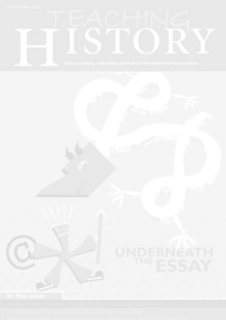Primary History articles
776 publications
-
 British National Curricula For History 1989-2011
British National Curricula For History 1989-2011
-
 Pupils as apprentice historians (2)
Pupils as apprentice historians (2)
-
 Dig it: Literacy, ICT, Archaeology and History
Dig it: Literacy, ICT, Archaeology and History
-
 Bringing an information text to life: Pets in the Blitz
Bringing an information text to life: Pets in the Blitz
-
 Learning to engage with documents through role play
Learning to engage with documents through role play
-
 Why did you write it like a story rather than just saying the information?
Why did you write it like a story rather than just saying the information?
-
 Difficult and challenging reading: Genre, text and multi-modal sources
Difficult and challenging reading: Genre, text and multi-modal sources
-
 Reading the Past: Written and printed sources
Reading the Past: Written and printed sources
-
 An integrated literacy and history unit of work
An integrated literacy and history unit of work
-
 Doing history in the early years and foundation stage
Doing history in the early years and foundation stage
-
 Printed pictures with text: Using cartoons as historical evidence
Printed pictures with text: Using cartoons as historical evidence
-
 Local history: young children using written, printed and multimodal sources
Local history: young children using written, printed and multimodal sources
-
 Using classic fiction to support the study of childhood in Victorian times
Using classic fiction to support the study of childhood in Victorian times
-
 Reading Sources Using Textbreaker
Reading Sources Using Textbreaker
-
 Sutton Hoo - Classroom archaeology in the digital age
Sutton Hoo - Classroom archaeology in the digital age
-
 Think Bubble 54 - Arte facts - Get my Meaning?
Think Bubble 54 - Arte facts - Get my Meaning?
-
 A history of the world - 100 objects that tell a story
A history of the world - 100 objects that tell a story
-
 Throw away the worksheets!
Throw away the worksheets!
-
 Extending Primary Children's thinking through artefacts
Extending Primary Children's thinking through artefacts
-
 A view from the KS1 classroom - investigating an artefact
A view from the KS1 classroom - investigating an artefact
-
 History, artefacts and storytelling in the 2011 primary curriculum
History, artefacts and storytelling in the 2011 primary curriculum
-
 Artefacts and art facts: images of Sir Francis Drake
Artefacts and art facts: images of Sir Francis Drake
-
 Doing history with objects - A museum's role
Doing history with objects - A museum's role
-
 'Doing Local History' through maps and drama
'Doing Local History' through maps and drama
-
 Case Study: Teaching World War 1 and professional development
Case Study: Teaching World War 1 and professional development
-
 Introducing local history: the Fusehill Workhouse Project
Introducing local history: the Fusehill Workhouse Project
-
 Oral history - a source of evidence for the primary classroom
Oral history - a source of evidence for the primary classroom
-
 Saltaire: Planning for an effective learning experience on a living site
Saltaire: Planning for an effective learning experience on a living site
-
 Using Spaces Near You
Using Spaces Near You
-
 ICT and Local History
ICT and Local History

